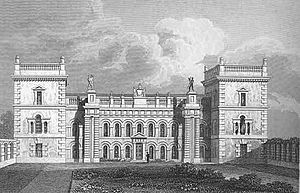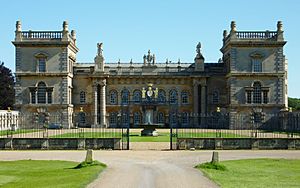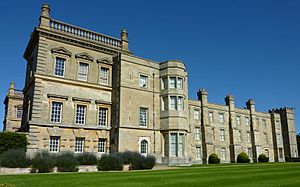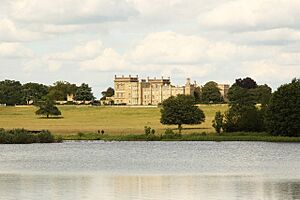Grimsthorpe Castle facts for kids
Grimsthorpe Castle is a grand country house in Lincolnshire, England. It's about 4 miles (6.4 km) north-west of Bourne. This amazing place sits within a huge 3,000-acre (12 km2) park. This park has rolling fields, beautiful lakes, and thick woodlands. A famous landscape designer named Capability Brown created its look.
Even though it's called a "castle," it's more like a very large, strong house. Its towers and other buildings make it look like a powerful fortress. Grimsthorpe has been the home of the de Eresby family since 1516. Today, Jane Heathcote-Drummond-Willoughby, 28th Baroness Willoughby de Eresby lives there. She is the granddaughter of Nancy Astor, who passed away at Grimsthorpe in 1964.
Contents
The Castle's Beginnings
Grimsthorpe Castle started as a smaller castle. It was built on a ridge, a raised area of land. This spot was important because it was on a road leading from the fen edge towards the Great North Road.
People believe Gilbert de Gant, Earl of Lincoln began building it in the early 1200s. However, he died in 1156. It's more likely the castle was built around 1140, during a time when many castles were being constructed in England. The tower at the south-east corner of the current building is thought to be part of the original castle. It's known as King John's Tower. This name might have made people think the castle was built during King John's time.
After Gilbert de Gant died, the castle probably went to the Earl of Chester. Later, during the time of the Plantagenet kings, Lord Lovell owned it. He was a strong supporter of Richard III. When Henry VII became king, Lord Lovell joined a rebellion. This rebellion failed, and his property, including Grimsthorpe, was taken away. It was then given to someone who supported the new Tudor Dynasty.
The Tudor Era at Grimsthorpe
In 1516, Henry VIII, King Henry VII's son, gave Grimsthorpe to the 11th Baron Willoughby de Eresby. The Baron also married Maria de Salinas, a Spanish lady-in-waiting to Queen Catherine of Aragon.
Their daughter, Katherine, inherited the castle and title when her father died in 1526. She was only seven years old. In 1533, she married Charles Brandon, 1st Duke of Suffolk. He was a close friend of King Henry VIII. In 1539, Henry VIII gave Charles Suffolk land from the nearby Vaudey Abbey, which had been closed down. Suffolk used stones from the abbey to help build and expand Grimsthorpe.
In just 18 months, the house was ready for a visit from King Henry VIII in 1541. He stayed there on his way to York. Later, in 1551, Mary of Guise, the widow of James V of Scotland, also stayed at Grimsthorpe. The new parts of the house were built quickly. Because of this, they needed many repairs later on. However, much of this Tudor house can still be seen today.
During Queen Mary I's reign, Katherine Brandon (née Willoughby) and her second husband, Richard Bertie, had to leave the castle. This was because they held Anglican religious views, which were not favored at the time. When Queen Elizabeth I became queen, they returned. They came back with their daughter, Susan, and their new son, Peregrine. Peregrine later became a soldier and spent much time away. Records from this time show that plays and puppet shows were performed for the family at Grimsthorpe.
Vanbrugh's Grand Design
By 1707, the 15th Baron Willoughby de Eresby had already rebuilt the north side of Grimsthorpe in a classical style. But in 1715, Robert Bertie, who was the 16th Baron, hired a famous architect named Sir John Vanbrugh. Vanbrugh was asked to design a grand Baroque front for the house. This was to celebrate Robert Bertie becoming the first Duke of Ancaster and Kesteven. This design is considered Vanbrugh's last great work.
Vanbrugh also drew plans for the other three sides of the house, but these were never built. His idea for the south side was in the Palladian style, which was a new trend then. It looked very different from his other designs.

Inside, Vanbrugh's hall is huge and impressive. It has stone arches on two levels. Arched screens at each end separate the hall from the staircases. The main staircase leads to the fancy rooms on the first floor. The State Dining Room is in Vanbrugh's north-east tower. It has a painted ceiling and a large Venetian window. This room holds the throne used by King George IV at his Coronation Banquet. There's also a throne used by Queen Victoria in the old House of Lords. Another special chair was made for King George III.
The King James and State Drawing Rooms have been redecorated over the years. They display portraits by famous artists like Reynolds and Van Dyck. You can also see European furniture and yellow tapestries from the 1730s. The South Corridor has thrones used by Prince Albert and Edward VII. Queen Victoria signed her coronation oath on a desk found here.
A series of rooms in the Tudor east wing have special oriel windows and decorated ceilings. The Chinese drawing room has a very rich ceiling and an 18th-century fan-vaulted oriel window. Its walls are covered with Chinese wallpaper showing birds among bamboo. The chapel is also magnificent, with beautiful 17th-century plasterwork.
The Beautiful Park
The park around Grimsthorpe Castle was once part of a large forest in Lincolnshire. It used to be a medieval deer park and a Tudor oak park. Today, you can see lovely avenues of trees crossing it. Some oak trees in the park were so old that they might have been growing there when the Domesday Book was written in 1086. Some of these ancient trees were still alive in the 1900s.
The current design of Grimsthorpe Castle park was created by Lancelot "Capability" Brown in 1771. The 3rd Duke of Ancaster, who owned the castle, helped make his plans happen. The garden has a knot garden, rose gardens with hedges, and a terrace with many different plants. There's also a summerhouse designed by Vanbrugh. The formal flower and topiary garden blends into the woodland garden. It also provides a nice setting for the vegetable garden and orchard, which were created in the 1960s. Close to the castle, you'll find detailed parterres marked with box hedges. A dramatic border of tall plants frames views across the lake.
Grimsthorpe in the 1800s
The 1st Earl of Ancaster was very interested in new technology. He tried to make the estate more productive in many ways. He showed early demonstrations of steam ploughing. He also built a private railway and used portable steam engines for sawing wood and pumping water.
Grimsthorpe in the 1900s

During the First World War, Grimsthorpe Park was used by the Royal Flying Corps and Royal Air Force. It served as an emergency landing ground for planes. In the Second World War, the middle part of the park, near the old Vaudey Abbey site, was used as a bombing range for training. In 1944, a company of the Parachute Regiment stayed at the castle. They were recovering from battles in Italy and training for a big operation called Operation Market Garden. Their flight to Arnhem started from RAF Folkingham.
Today, Grimsthorpe Castle and Drummond Castle are owned and managed by a special trust.
Grimsthorpe in the 2000s
Since 2021, the Festival of the Unexceptional has been held at Grimsthorpe Castle. This festival celebrates unusual and often overlooked classic cars.
Art Collection
Grimsthorpe Castle is home to a life-sized portrait by Francisco de Zurbarán of Benjamin. This painting is special because it's the only one separated from Zurbarán's famous series called Jacob and his twelve sons, which is kept at Auckland Castle. There is a copy of the Benjamin painting at Auckland Castle.





